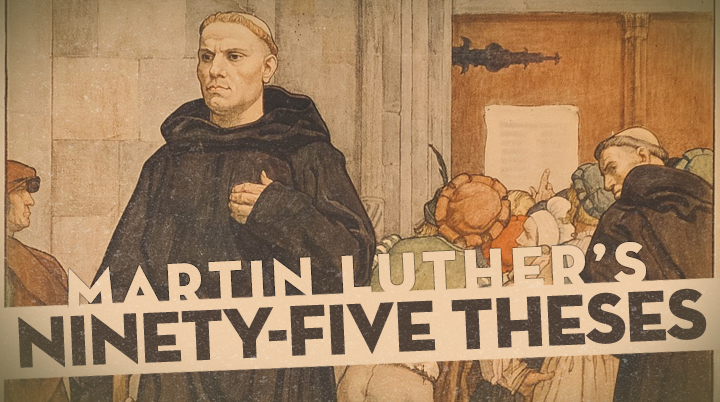The Five Hundredth Anniversary of the Protestant Reformation

A brief retelling of the birth of the Protestant Reformation with the hanging of Luther’s 95 Theses on October 31, 1517.
This approaching October 31, 2017, when most people in the USA will be celebrating “Hallow-een,” with pumpkins, eating pumpkin pie, going “trick-or-treat”-ing, and make-believe witches riding broomsticks, Christians will either be in worship on All-Saints Eve –November 1st is all Saints’ Day with a reading from Hebrews 11:1-12:3 – or celebrating the “eve” of the Protestant Reformation.
On October 31, 1517, an Augustinian monk walked from the monastery and school where he taught to All Saints Cathedral in Wittenberg, a city in the electorate of Saxony in present-day Germany. Clenched in his fist was a rolled-up scroll which was flattened out on the door of the Cathedral and then secured there. On the scroll were 95 theses as an invitation to a debate. The monk’s name was Martin Luther, the son of Hans and Margarethe (nee: Lindemann) Luther.
Luther got the debate he wanted but the “protest” he made was “contested” by one John Eck who sided with the wishes of Pope Leo X.
Luther became the center of attention throughout Europe. The nailing of the 95 Theses on the door of all Saints Cathedral was not the one incident which brought about European-wide attention. What did bring attention was the circulation of the 95 Theses in several cities from east to west and north and south throughout the German domains—Saxony, Bavaria, the Rhineland, the Palatine, Austria, and Alsace-Lorraine, and also into Switzerland. In point of fact, it took twelve years for an actual “Protestant Reformation” to take place. It was on April 19, 1529, when six Princes and representatives of 14 imperial Free Cities gathered at the Memorial Church in the city of Speyer to issue a petition calling for the Imperial Diet to not hinder the spread of the evangelical faith as expounded by the Lutherans across the whole of Europe. It was called a “Protest.” Since it was a Testimony on behalf of Luther and the spread of what he represented, it was called the “Letter of Protestation.” It was printed and made public. It was signed by Johann, Elector of Saxony; Georg, Margrave of Brandenburg; Ernst, Duke of Braunschweig-Lineburg; Philipp, Landgrave of Hesse; and Wolfgang, Prince of Anhalt.
The text was then sent to the Holy Roman Emperor by an embassy. From this time the supporters of Luther were called “Protestants,” and not because of what they were against but what they were for. Later the term “Protestant” was used to designate the whole renewal movement which included the “reforms” sought by John Calvin, Huldrich Zwingli, Bathasar Hubmaier, Menno Simons, and others. The story of the Reformation is much larger than Luther and that is another story in and of itself.
Luther’s letter of protest on October 31, 1517 lit the fires of renewal across all of Europe and into England, which has since become referred to the Protestant Reformation.
Category: Church History, Fall 2017


